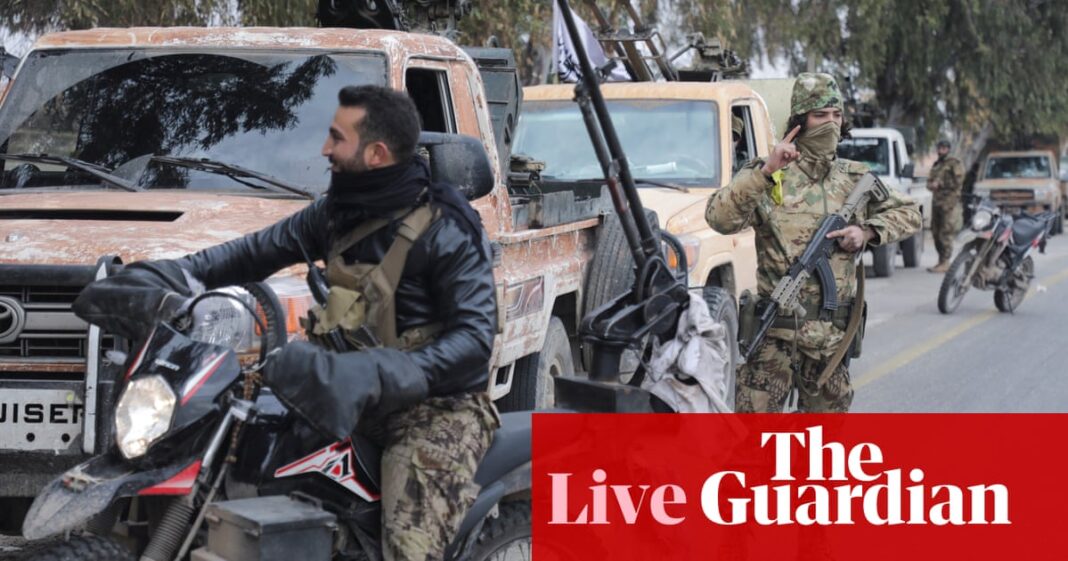Syrian rebels reach Damascus suburbs – rebel commander
Syrian insurgents have reached the suburbs of Damascus, opposition activists and a rebel commander said on Saturday, as a rapidly moving offensive in which they have taken over some of Syria’s largest cities continued.
Rami Abdurrahman, who heads the UK-based Syrian Observatory for Human Rights, an opposition war monitor, said insurgents were active in the Damascus suburbs of Maadamiyah, Jaramana and Daraya.
He said opposition fighters were also marching from eastern Syria towards the Damascus suburb of Harasta.
Hassan Abdul-Ghani, an insurgent commander, posted on Telegram that opposition forces had started to encircle Damascus in the “final stage” of their offensive. He said fighters were heading from southern Syria towards Damascus.
We will bring you live updates on this developing story.
Key events
Faisal Ali
Abu Mohammed al-Jolani, leader of HTS, the armed group spearheading the charge against the Assad regime, has urged his fighters to “show mercy” and “protect those who surrender” in a video message.
Jolani said his group was in the “final moments” before the capture of Homs, adding that it would be a “historic event.”
It will be the third major city HTS has captured since its fighters fanned out from Idlib at the end of November.
Ruth Michaelson
An insurgent commander said that forces spearheaded by Hay’at Tahrir al-Sham are combing Homs after forces loyal to Damascus have fled.
“An incursion into the neighbourhoods of the city is now underway and we are combing it in preparation for declaring it completely liberated,” said Lt Col Hassan Abdul–Ghani in a statement.
Homs is a city of strategic and hugely symbolic importance to the militants and to the opposition as a whole. The city is a key juncture on the highway that leads to the capital Damascus, connecting it with coastal regions traditionally loyal to Assad.
It also saw some of the fiercest fighting in the early years of Syria’s civil war, when rebels battled to seize neighbourhoods from president Bashar al-Assad’s control.
The loss of Homs would mean that Syria’s major provincial capitals would no longer be controlled by Assad’s regime in Damascus, fundamentally altering his grip on the country his family has ruled for decades.
Government forces withdraw from much of central city of Homs
AP has a quick snap that government forces have withdrawn from much of the central city of Homs, according to a Syrian opposition war monitor and a pro-government media outlet.
More details soon …
Syrian rebel commander Hassan Abdul–Ghani said rebel forces had entered the key city of Homs.
Dozens of fighters from Hezbollah’s elite Radwan forces fled the Syrian city of Homs, Reuters reports, after a decision was taken with the Syrian army that the city could no longer be defended.
Rebel fighters claim to have entered key city of Homs – report
William Christou
Syrian opposition media reports that Syrian government forces have withdrawn from Homs city and fighters from Hay’at Tahrir al-Sham (HTS) have entered the city proper.
Videos showed members of state security branches fleeing their posts in Homs before the rebel advance. Syrian state media did not acknowledge the loss of the city, but said that HTS fighters had entered the city’s suburbs and outlying villages.
If Homs were to fall to rebels, Damascus would be cut off from Tartous and Latakia – coastal provinces where Bashar al-Assad has historically enjoyed strong support. Rebel forces would then be approaching the country’s capital city from the north from Homs, from the south from Daraa and Suwayda province and from the east from the ancient city of Palmyra.
Here are some of the latest images from inside Syria sent to us over the news wires:
Lebanon’s health ministry said on Saturday that Israeli airstrikes had killed six people in the country’s south, just 10 days into a ceasefire between Hezbollah and Israel.
Agence France-Presse reports that both Israel and the Iran-backed Hezbollah have been accused of violating the truce, which took effect on 27 November to end a conflict that has left thousands dead in Lebanon and caused mass displacement on both sides.
According to the ministry, “The Israeli enemy’s airstrike on the town of Beit Lif resulted in the martyrdom of five people and the injury of five others.” It added that a separate drone strike killed one person in the town of Deir Seryan.
Residents of isolated Syrian refugee camp liberated after more than 10 years
William Christou
Residents of al-Rukban camp rejoiced on Saturday night, after the Syrian army soldiers which had enforced a more than six-year-long siege on the camp abandoned their positions and fled.
Al-Rukban, a camp formed in 2014 in the arid no man’s land between Syria and Jordan, houses about 10,000 refugees who fled the Syrian government’s crackdown on protesters during the country’s revolution. In 2018, the Syrian army and the Jordanian government imposed a siege on the camp, forcing residents to survive on meager amounts of food brought in periodically by a few smugglers.
“I cannot describe the feelings, the words don’t exist. I will be able to return to my village after 14 years,” said Yasser, a resident of the camp originally from a village outside Homs in central Syria speaking under a pseudonym in case government forces returned. Yasser had read a few hours earlier that the Syrian army had been driven out of his home town by rebels led by the Islamist group Hayat Tahrir al-Sham (HTS) as part of its attempt to take Homs city.
Pictures sent to the guardian showed Syrian army vehicles, tanks and artillery abandoned where soldiers had fled or had been killed by members of the Free Syrian Army. The Free Syrian Army had patrolled the 55-kilometer demilitarized zone around the camp, supervised by US forces as part of its global coalition to defeat the Islamic State.
On Saturday, the Free Syrian Army had broken out of the demilitarized zone, killing the remaining Syrian army soldiers and capturing the ancient city of Palmyra.
Leaving al-Rukban had been a dream for Yasser and for the other camp residents. Living conditions in the camp had deteriorated in recent years, with food and medical supplies scarce. Syrian soldiers had tightened their siege on the camp, preventing smugglers from reaching the camp. During the last survey of a UN clinic before it closed down in 2020, almost 100% of children under five who went to the clinic were malnourished.
Still, camp residents had to wait before they could return home. The area around the demilitarized zone had been heavily mined, and would take some time to clear.
“We have to wait around 20 days. I will be counting every second,” Yasser said.
Amid rampant speculation as to the whereabouts of President Bashar al-Assad as the rebel offensive presses ever closer to the capital, Bloomberg’s Sam Dagher reports that the leader of an increasingly shrinking rump state is making a last-ditch effort to hold on to power. This includes indirect diplomatic overtures to the US and President-elect Donald Trump.
One proposal, according to Dagher, conveyed through the United Arab Emirates, offers to sever Syria’s ties with Iran-backed militant groups like Hezbollah – but only if western powers use their influence to curb the fighting.
Assad has ordered his army to retreat and focus on defending Damascus, effectively relinquishing control of much of the country.

Robert Mackey
As government forces withdraw from cities and towns across Syria, there is a scramble to preserve documents that could be used to hold members of President Bashar al-Assad’s regime to account for crimes against humanity. The Syrian journalist Qusay Noor points to video that appears to show “a huge warehouse of records and reports on citizens in the Political Security Branch” in the city of Suwayda.
Allow content provided by a third party?
This article includes content hosted on embed.bsky.app. We ask for your permission before anything is loaded, as the provider may be using cookies and other technologies. To view this content, click ‘Allow and continue’.
But, according to Rim Turkmani, director of the Syria conflict research programme at the London School of Economics: “The notorious State Security branch of Mukhabarat in Homs has evacuated its building, setting tons of documents – evidence of their crimes – ablaze on the roof. Friends in the city witnessed the evacuation from their balconies, and now, many in Homs are overwhelmed with tears of relief and joy.”
“As opposition forces continue to take control of key sites across Syria – central offices, prisons, political, intelligence offices, and military branches – we are witnessing a historical moment in the search for justice!” Rawan Shaif of Amnesty International notes on Bluesky. “These documents are not just pieces of paper – they are the threads that connect us to the past and to the hope for accountability. They hold the potential to expose the full extent of the crimes committed and the perpetrators behind them. They are essential for holding individuals, command, and perpetrators accountable and ensuring that justice is pursued. But the road ahead requires preservation; these materials, these records and accounts, must be safeguarded, archived, and kept secure. Some incredibly emotional times ahead, but the work is just beginning.”





